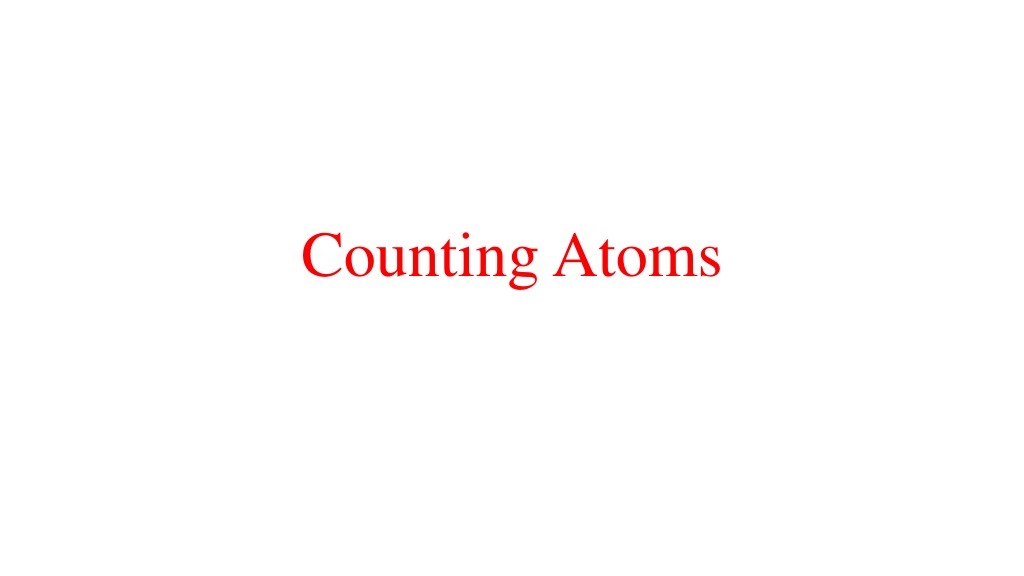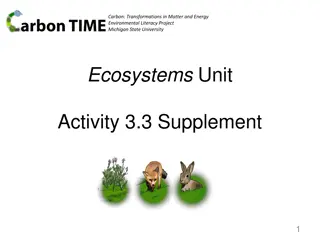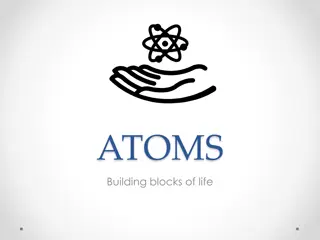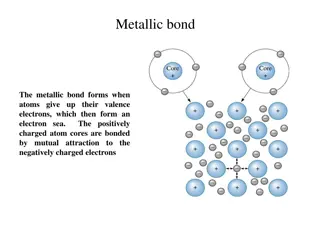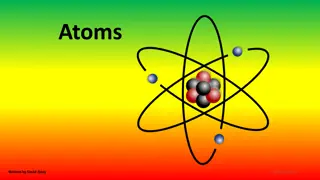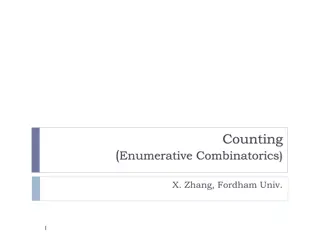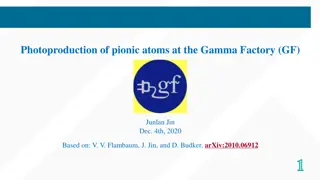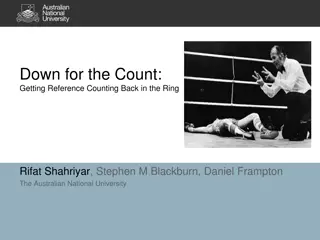Counting Atoms
All atoms of an element have the same number of protons but can differ in neutrons, leading to isotopes. Learn about isotopes like protium, deuterium, and tritium of hydrogen, and how mass number defines them. Discover how to identify isotopes using hyphen notation or nuclear symbols.
Download Presentation

Please find below an Image/Link to download the presentation.
The content on the website is provided AS IS for your information and personal use only. It may not be sold, licensed, or shared on other websites without obtaining consent from the author.If you encounter any issues during the download, it is possible that the publisher has removed the file from their server.
You are allowed to download the files provided on this website for personal or commercial use, subject to the condition that they are used lawfully. All files are the property of their respective owners.
The content on the website is provided AS IS for your information and personal use only. It may not be sold, licensed, or shared on other websites without obtaining consent from the author.
E N D
Presentation Transcript
Counting Atoms All atoms of an element must have the same number of protons but not neutrons All atoms contain the same particles. Yet all atoms are not same. Atoms of different elements have different number of protons. Atoms of the same element all have the same number of protons. The atomic number (Z) of an element is the number of protons in each atom of that element. Hydrogen, H, has an atomic number of 1. All atoms of the element hydrogen have one proton. The atomic number identifies an element. If the number of protons in the nucleus of an atom were to change, that atom would become a different element.
Counting Atoms Isotopes But just because all hydrogen atoms, for example, have only a single proton, it doesn t mean they all have the same number of neutrons, or even any neutrons at all. The most common type of hydrogen is sometimes called protium. It accounts for 99.9885% of the hydrogen atoms found on Earth, and its nucleus consists of only a single proton. Another type of hydrogen, deuterium, accounts for 0.0115% of Earth s hydrogen atoms; its nucleus has one proton and one neutron. The third form of hydrogen, tritium, has one proton and two neutrons in its nucleus. Tritium is radioactive, so it is not very common at all on Earth. However, it is still hydrogen.
Counting Atoms Isotopes
Counting Atoms Isotopes Protium, deuterium, and tritium are isotopes of hydrogen. Isotopes are atoms of the same element that have different masses. The isotopes of a particular element all have the same number of protons and electrons but different number of neutrons.
Counting Atoms Mass number The mass number is the total number of protons and neutrons that make up the nucleus of an isotope (or an atom).
Counting Atoms Identifying isotopes There are two methods for specifying isotopes. In the first, the mass number appears with a hyphen after the name of the element. Tritium is written as hydrogen-3. This is hyphen notation. The Uranium isotope with mass number 235, commonly used as fuel for nuclear power plants, is known as uranium-235. The second method shows the composition of a nucleus using the isotope s nuclear symbol. So uranium-235 is . The superscript indicates the mass number (protons + neutrons)
Counting Atoms Identifying isotopes
Counting Atoms Atomic mass is a relative measure Masses of atoms expressed in grams are very small. An atom of oxygen-16, has a mass of 2.656 X 10-23g. For most chemical calculations, it is more convenient to use relative atomic masses. Scientists use standards of measurement that are constant and the same everywhere. In order to set up a relative scale of atomic mass, one atom has been arbitrarily chosen as the standard and assigned a mass value. The masses of all other atoms are expressed in relation to this standard.
Counting Atoms Atomic mass is a relative measure The standard used by scientists to compare units of atomic mass is the carbon-12 atom, which has been arbitrarily assigned a mass of exactly 12 unified atomic mass units, or 12 u. One unified atomic mass unit, or 1u, is exactly 1/12 the mass of a carbon-12 atom. The atomic mass of any other atom is determined by comparing it with the mass of the carbon-12 atom. The hydrogen-1 atom has an atomic mass of about 1/12 that of the carbon-12 atom, or about 1u. The masses of subatomic particles can also be expressed on the atomic mass scale. The mass of the electron is 0.000 548 6u, that of proton is 1.007 276 u, and that of neutron is 1.008 665 u Note that proton and neutron masses are close, but not equal, to 1u.
Counting Atoms Average atomic mass is weighted value. Most elements occur naturally as mixture of isotopes. Scientists determine the average mass of a sample of an element isotopes by determining the percentages of each of the isotopes and then giving the proper weight to each value. Average atomic mass is the weighted average of the atomic masses of the naturally occurring isotopes of an element. Unlike, atomic number, average atomic mass is a statistical calculation.
Counting Atoms Average atomic mass is weighted value. Calculate weighted average Suppose, we have a box containing two sizes of marbles. If 25% of the marbles have masses of 2 g each and 75% have masses of 3 g each. If you had 100 marbles, then: 25 marbles X 2 g = 50 g 75 marbles X 3 g = 225g Total mass of the marbles = 50 g+ 225g =275 g Average marble mass = 275/100 = 2.75 g A simple method is to multiply the mass of each marble by the decimal fraction representing it percentage in the mixture. Then add the products. 25% = 0.25 75% = 0.75 (2g X 0.25) + ( 3g X 0.75) = 2.75 g
Counting Atoms Calculate weighted average Score Number of students 95 4 91 6 86 6 83 1 88 8 62 3 Calculate the class average?
Counting Atoms Average atomic mass is weighted value.
Counting Atoms Average atomic mass is weighted value- Calculating Average atomic mass The average atomic mass of an element depends on both the mass and the relative abundance of each of the element s isotopes. For example, naturally occurring copper consists of 69.15% copper-63,which has an atomic mass of 62.929 601u, and 30.85% copper-65, which has an atomic mass of 64.927 794u. The average atomic mass of copper can be calculated by multiplying the atomic mass of each isotope by its relative abundance (expressed in decimal form) and adding the results. 0.6915 X 62.929 601u +0.3085 X 64.927 794u = 63.55 u The calculated average atomic mass of naturally occurring copper is 63.55u.
Counting Atoms A relative mass scale makes counting atoms possible. The relative atomic mass scale makes it possible to know how many atoms of an element are present in a sample of the element with a measurable mass. The mole The mole is the SI unit for amount of substance. A mole is the amount of a substance that contains as many particles as there are atoms in exactly 12 g of carbon-12. The mole is a counting unit, just like a dozen is.
Counting Atoms A relative mass scale makes counting atoms possible. Avogadro s Number The number of particles in a mole has been experimentally determined in a number of ways. The best modern value is 6.02214179 X 1023. This means that exactly 12g of carbon-12 contains 6.02214179 X 1023 carbon-12 atoms. The number of particles in a mole is known as Avogadro s number. Avogadro s number is the number of particles in exactly one mole of a pure substance.
Counting Atoms A relative mass scale makes counting atoms possible. Molar mass Can you calculate the approximate mass of one mole of helium atoms? A mole of carbon-12 atoms has a mass of exactly 12g and that a carbon- 12 atom has an atomic mass of 12u. The atomic mass of a helium atom is 4u, which is about 1/3 the mass of a carbon-12 atom. It follows that a mole of helium atoms will have about 1/3 the mass of a mole of carbon-12 atoms. Thus, one mole of helium has a mass of about 4g.
Counting Atoms A relative mass scale makes counting atoms possible. Molar mass The mass of one mole of a pure substance is called the molar mass of that substance. Molar mass is usually written in units of g/mol. The molar mass of an element is numerically equal to the atomic mass of the element in unified atomic mass units (which can be found from the periodic table). For example, the molar mass of lithium, Li, is 6.94 g/mol, while the molar mass of mercury, Hg, is 200.59g/mol. The molar mass of an element contains one mole of atoms. For example, 4 g of helium, 6.94 g of lithium, and 200.59 g of mercury all contains a mole of atoms.
Counting Atoms Chemist use molar mass as a conversion factor in chemical calculations. For example, the molar mass of helium is 4g He/mol He. To find how many grams of helium there are in two moles of helium, multiply by the molar mass 2 mol He X 4 ? ?? 1 ??? ??= 8 g He
Counting Atoms 1- What is the mass in grams of 3.5 mol of the element copper, Cu? 2-A chemist produced 11.9 g of aluminium, Al. How many moles of aluminium were produced? 3- How many moles of silver, Ag, are in 3.01 X 1023atoms of silver?
Counting Atoms 1) Given: 3.5 mol Cu Unknown: mass of Cu in grams Amount of Cu in moles mass of Cu in grams The mass of an element in grams can be calculated by multiplying the amount of the element in moles by the element s molar mass. moles Cu X ????? ?? ????? ??= grams Cu The molar mass of copper from the periodic table is rounded to 63.55 g/mol 3.5 mol Cu X 63.55 g ?? 1 ??? ??= 222 g Cu
Counting Atoms 2) Given: 11.9 g Al Unknown: amount of Al in moles Mass of Al in grams amount of Al in moles Amount in moles can be calculated by dividing mass in grams by molar mass, which is mathematically same as multiplying mass in grams by the reciprocal of molar mass. Grams Al X ????? ?? ????? ??= moles Al The molar mass of aluminium from the periodic table is rounded to 26.98 g/ mol. 11.9 g Al X 26.98 g Al= 0.441 mol Al 1 ??? ??
Counting Atoms 3) Given: 3.01 X 1023atoms of Ag Unknown: amount of Ag in moles Number of atoms of Ag amount of Ag in moles Number of atoms is converted to amount in moles by dividing by Avogadro s number. This is equivalent to multiplying numbers of atoms by the reciprocal of Avogadro s number. ????? ?? ???????? ? ?????? ?? ?? ?????= moles Ag 3.01 X 1023Ag atoms X 6.022 X 1023 Ag atoms= 0.500 mol Ag Ag atoms X 1 ??? ??
